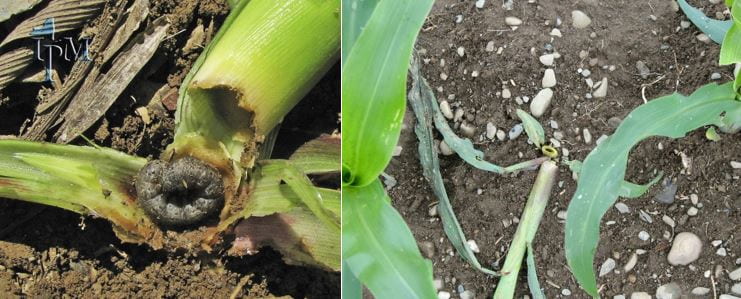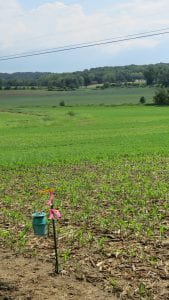Black Cutworm and True Armyworm Monitoring Underway in NY
By Jaime Cummings and Ken Wise of NYS Integrated Pest Management Program
As black cutworm (BCW) moths have been identified in surrounding states, including Pennsylvania and Indiana, this last week in April marks the traditional timing for deployment of pheromone traps in NY to monitor for BCW moths. Since 2015, the NYS IPM program has coordinated these statewide monitoring efforts in cooperation with numerous Cornell Cooperative Extension (CCE) educators, farmers and crop advisors. Since BCW is a migratory pest, which arrives on the winds of storms coming up from southern states, knowing when it reaches NY helps us predict when we need to start monitoring for cutting of corn seedlings by BCW caterpillars. Scouting for significant populations helps farmers make informed management decisions. Check newly planted fields every few days for signs of missing, cut or wilted plants, and search for the larvae just below the soil surface near damaged plants (Fig. 1). The economic threshold for BCW treatment is reached when 5% or more plants in the stand have been cut. The larvae are best controlled when small (< ½”), and soil-applied insecticide rescue treatments at the time of infestation is the most economical and effective management option for BCW infestations. Lorsban, Pounce and Warrior II all have efficacy against BCW (always consult labels for rates and instructions), and Poncho and Cruiser seed treatments are also labeled for BCW. Spot treatment is recommended for infested areas of fields, with a 20-40’ surrounding border. Replant may be necessary if damage is too severe to manage with insecticide.
Figure 1. Black cutworm larva and damage. (Photos courtesy of Ken Wise, NYS IPM)
True armyworms (TAW), another long-ranged migrant from the south, is an inconsistent early-season pest of corn that we are also monitoring for with pheromone traps this spring. These moths are attracted to weedy or grassy fields, where they will lay their eggs which will hatch and result in numerous larvae moving into crop fields. Similar to BCW monitoring, the TAW pheromone traps alert us as to the arrival of these moths so that we can predict when we should be scouting for the damaging larvae. While out scouting for BCW, you should also be on the lookout for TAW damage, which includes ragged holes and leaf margins and abundant pellet-like frass on and around damaged plants (Fig. 2). The larvae are often found in the whorls or on the soil surface near damaged plants. The economic threshold for TAW treatment is when >50% of plants show damage and if you count three or more larvae per plant when corn is in whorl stage or younger. Older corn can tolerate some feeding, and seldom requires treatment. Lorsban and Pounce have efficacy against BCW (always consult labels for rates and instructions). Spot treatment is recommended for infested areas of fields, with a 20-40’ surrounding border.
Figure 2. True armyworm damage and larva with frass. (Photos courtesy of Ken Wise, NYS IPM)
2019 marks the 5th year of this statewide pheromone trap monitoring network for these pests in NY, and you may see the telltale green bucket traps in your area (Fig. 3). This year we have 27 traps each for BCW and TAW in 17 counties, broadly covering all field crop production areas of the state. Financial support for these efforts comes from USDA-NIFA CPPM, and wouldn’t be possible without the dedicated cooperation of many CCE, farmer and crop consultant collaborators. Monitoring and scouting for pests leads to sound management decisions and the highest economic return on investment for pest management. For updates on the progress of these monitoring efforts, please subscribe to the NYS IPM Weekly Pest Report.
Figure 3. The green bucket trap with pheromone lure used to monitor pest migration. (Photo courtesy of Ken Wise, NYS IPM)



